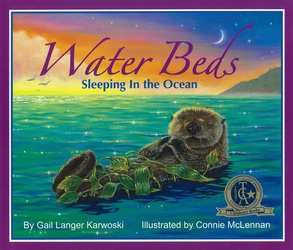Water Beds Activity Page
Click HERE to hear Water Beds: Sleeping in the Ocean read aloud.
Click HERE to hear another reading of Water Beds: Sleeping in the Ocean.
Click HERE to hear another reading of Water Beds: Sleeping in the Ocean.
Water Tables: Feasting in the Ocean
In this activity, students research, write, and illustrate a companion to Water Beds; Sleeping in the Ocean (South Carolina: Arbordale, 2005).
Materials:
paper
crayons, markers, etc.
hole-punch & yarn, or spiral-binding machine to assemble book
reference materials, such as encyclopedias
Procedures:
Share Water Beds; Sleeping in the Ocean.
Have students work with partners or in groups. Assign each group one of the 10 marine mammals in the book: orca, beluga, humpback, bottlenose dolphin, sea otter, harbor seal, walrus, elephant seal, northern fur seal, manatee. (You may also add other marine mammals, such as gray whale, spinner dolphin, sea lion, dugong.)
Have the groups research the eating habits of their marine mammal. Then have each group write a short description of their animal’s “water table” and illustrate it.
If you’d like, you may use these sentences for the opening page of the book, to mirror the opening page of Water Beds; Sleeping in the Ocean:
“It’s mealtime for mammals! You swallow your sandwich and slurp up your soup. But have you ever wondered what it would be like to dine in the deep?”
Here’s the ending page to mirror the final page of Water Beds; Sleeping in the Ocean:
“It’s fun to imagine a marine mammal’s meal. But a clean, cozy kitchen is the perfect spot for your breakfast. Open your mouth, human mammal, and munch on your lunch! Dive into dinner with fork, knife, and spoon. As you nibble your nuggets and chew on your stew, think of snapping up supper like sea mammals do.”
Assemble the pages into a class book entitled, Water Tables; Feasting in the Ocean.
Variation:
Instead of researching the eating habits of marine mammals, have your students identify land mammals and research/write a book about their sleeping (or eating) habits.
Note: Special thanks to teacher, Karin Coburn, of Fairfax County Schools, Virginia, for sharing this idea with me.
Thanks also to the PACE students of teacher, Joyce Henson, Oconee County Schools, Georgia, for “trying out” this lesson plan and sharing their finished books; I have displayed some of their pages, above.
Materials:
paper
crayons, markers, etc.
hole-punch & yarn, or spiral-binding machine to assemble book
reference materials, such as encyclopedias
Procedures:
Share Water Beds; Sleeping in the Ocean.
Have students work with partners or in groups. Assign each group one of the 10 marine mammals in the book: orca, beluga, humpback, bottlenose dolphin, sea otter, harbor seal, walrus, elephant seal, northern fur seal, manatee. (You may also add other marine mammals, such as gray whale, spinner dolphin, sea lion, dugong.)
Have the groups research the eating habits of their marine mammal. Then have each group write a short description of their animal’s “water table” and illustrate it.
If you’d like, you may use these sentences for the opening page of the book, to mirror the opening page of Water Beds; Sleeping in the Ocean:
“It’s mealtime for mammals! You swallow your sandwich and slurp up your soup. But have you ever wondered what it would be like to dine in the deep?”
Here’s the ending page to mirror the final page of Water Beds; Sleeping in the Ocean:
“It’s fun to imagine a marine mammal’s meal. But a clean, cozy kitchen is the perfect spot for your breakfast. Open your mouth, human mammal, and munch on your lunch! Dive into dinner with fork, knife, and spoon. As you nibble your nuggets and chew on your stew, think of snapping up supper like sea mammals do.”
Assemble the pages into a class book entitled, Water Tables; Feasting in the Ocean.
Variation:
Instead of researching the eating habits of marine mammals, have your students identify land mammals and research/write a book about their sleeping (or eating) habits.
Note: Special thanks to teacher, Karin Coburn, of Fairfax County Schools, Virginia, for sharing this idea with me.
Thanks also to the PACE students of teacher, Joyce Henson, Oconee County Schools, Georgia, for “trying out” this lesson plan and sharing their finished books; I have displayed some of their pages, above.




